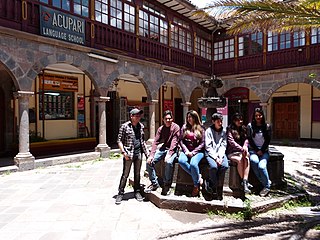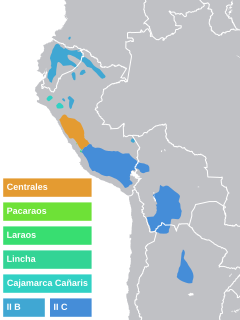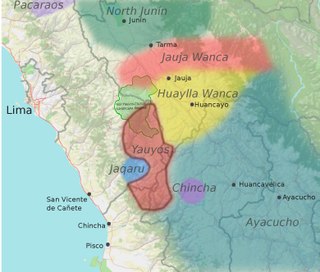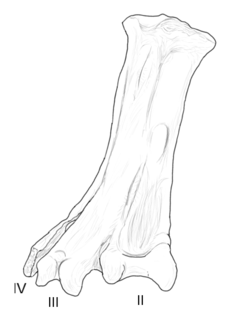 W
WQuechua, usually called Runasimi in Quechuan languages, is an indigenous language family spoken by the Quechua peoples, primarily living in the Peruvian Andes. Derived from a common ancestral language, it is the most widely spoken pre-Columbian language family of the Americas, with an estimated 8–10 million speakers as of 2004. Approximately 25% of Peruvians speak a Quechuan language. It is perhaps most widely known for being the main language family of the Inca Empire. The Spaniards encouraged its use until the Peruvian struggle for independence of the 1780s. As a result, Quechua variants are still widely spoken today, being the co-official language of many regions and the second most spoken language family in Peru.
 W
WThe Cultural Association ACUPARI is the responsible body of the same named language school for German, Spanish and Quechua in Cusco, Peru. The aim of this German Peruvian Cultural Association is to develop the intercultural dialogue between these two countries. For this reason ACUPARI partners with the Goethe-Institut and is a certified member of the network for language schools TANDEM International.
 W
WAncash Quechua, or Huaylay (Waylay), is a Quechua variety spoken in the Peruvian department of Ancash by approximately 1,000,000 people. Like Wanka Quechua, it belongs to Quechua I.
 W
WRenata Flores Rivera is a Peruvian singer, made famous in Latin America by a viral Quechua cover of Michael Jackson's "The Way You Make Me Feel", released in 2015.
 W
WHanacpachap cussicuinin is a processional hymn to the Virgin Mary in the Quechua language but in a largely European sacred music style. Composed by Juan Pérez de Bocanegra between 1620 and 1631, a Franciscan priest, published in 1631 in the Viceroyalty of Peru making it the earliest work of vocal polyphony printed in the New World.
 W
WHuallaga Quechua is a dialect within the Alto Pativilca–Alto Marañón–Alto Huallaga dialect cluster of the Quechua languages. The dialect is spoken in the Central Huánuco region of Perú, primarily in the Huánuco Province districts of Huánuco, Churubamba, Santa María del Valle, San Francisco de Cayrán, and Conchamarca.
 W
WHuaylas Quechua is an Ancash Quechua dialect spoken in the Callejón de Huaylas and in the western slope of the Cordillera Negra.
 W
WThe Hutts are an alien species in the Star Wars franchise. Hutts are rotund, voracious and grotesque-looking slug-like creatures with a predisposition to being involved as leaders in organized crime. The most famous Hutt and the first to be depicted, from whose design template other members of the race is derived, is Jabba the Hutt, who appears in the films Return of the Jedi, the Special Edition release of A New Hope, and The Phantom Menace. Both Jabba and numerous other Hutts additionally feature in various works of the Star Wars expanded universe, which greatly elaborates on their kind's history, culture and role in galactic society at large.
 W
WIschigualastia is an extinct genus of dicynodonts, that lived during the Carnian age of the Late Triassic Period. The genus was found in and named after the Ischigualasto Formation of the Ischigualasto-Villa Unión Basin in northwestern Argentina. It has been placed in the family Stahleckeriidae.
 W
WThe Ischigualasto Formation is a Late Triassic fossiliferous formation and Lagerstätte in the Ischigualasto-Villa Unión Basin of the southwestern La Rioja Province and northeastern San Juan Province in northwestern Argentina. The formation dates to the Carnian age and ranges between 231.7 and 225 Ma, based on ash bed dating.
 W
WIschigualasto Provincial Park, also called Valle de la Luna, due to its moon like appearance, is a provincial protected area in the north-east of San Juan Province, north-western Argentina, limiting to the north with the Talampaya National Park, in La Rioja Province. Both areas belong to the same geological formation, the Ischigualasto Formation . Established on 3 November 1971, the park has an area of 60,370 ha.
 W
WThe Ischigualasto-Villa Unión Basin is a small sedimentary basin located in the Argentine Northwest, Argentina. It is located in the southwestern part of La Rioja Province and the northeastern part of San Juan Province. The basin borders the Sierras Pampeanas in the east, the western boundary of the basin is formed by the Valle Fértil Fault, bordering the Precordillera, and it is bound in the southeast by the El Alto Fault, separating the basin from the Marayes-El Carrizal Basin.
 W
WKichwa is a Quechuan language that includes all Quechua varieties of Ecuador and Colombia (Inga), as well as extensions into Peru. It has an estimated half million speakers.
 W
WRicardo Flores Carrasco, known professionally as Liberato Kani, is a Quechua-language hip-hop singer and songwriter. Through his work, he is also a cultural and Indigenous Languages activist.
 W
WMedia Lengua, also known as Chaupi-shimi, Chaupi-lengua, Chaupi-Quichua, Quichuañol, Chapu-shimi or llanga-shimi, is a mixed language with Spanish vocabulary and Kichwa grammar, most conspicuously in its morphology. In terms of vocabulary, almost all lexemes (89%), including core vocabulary, are of Spanish origin and appear to conform to Kichwa phonotactics. Media Lengua is one of the few widely acknowledged examples of a "bilingual mixed language" in both the conventional and narrow linguistic sense because of its split between roots and suffixes. Such extreme and systematic borrowing is only rarely attested, and Media Lengua is not typically described as a variety of either Kichwa or Spanish. Arends et al., list two languages subsumed under the name Media Lengua: Salcedo Media Lengua and Media Lengua of Saraguro. The northern variety of Media Lengua, found in the province of Imbabura, is commonly referred to as Imbabura Media Lengua and more specifically, the dialect varieties within the province are known as Pijal Media Lengua and Angla Media Lengua.
 W
WDina Páucar is an Peruvian Andean music singer and composer.
 W
WThe Quechua Alliance is a community organization that promotes and celebrates Andean culture in the United States.
 W
WQuechua I, also known as Quechua Wáywash, or Quechua B, is one of the two branches or genealogical groups of the Quechua languages. It is composed of a great diversity of linguistic varieties distributed in the mountains of central Peru, in the departments of Ancash, Huánuco, Pasco, Junín and Lima. This Quechua I differs from the Quechua II by the use of long vowels and in several morphemes. According to the linguists Torero and Carranza, they are older than Quechua II.
 W
WSouthern Quechua, or simply Quechua, is the most widely spoken of the major regional groupings of mutually intelligible dialects within the Quechua language family, with about 6.9 million speakers. It is also the most widely spoken indigenous language in the Americas. The term Southern Quechua refers to the Quechuan varieties spoken in regions of the Andes south of a line roughly east–west between the cities of Huancayo and Huancavelica in central Peru. It includes the Quechua varieties spoken in the regions of Ayacucho, Cusco and Puno in Peru, in much of Bolivia and parts of north-west Argentina. The most widely spoken varieties are Cusco, Ayacucho, Puno (Collao), and South Bolivian.
 W
WYauyos–Chincha Quechua or Yauyos Quechua is a dialect cluster of Quechua, spoken in the Yauyos and Chincha districts of Peru. There are numerous dialects: in Yauyos, San Pedro de Huacarpana, Apurí, Madean-Viñac (Madeán), Azángaro-Huangáscar-Chocos (Huangáscar), Cacra-Hongos, Tomás-Alis (Alis), Huancaya-Vitis, Laraos, with similar diversity in Chincha.
 W
WYungavolucris is a genus of enantiornithean birds. It contains the single species Yungavolucris brevipedalis, which lived in the Late Cretaceous. The fossil bones were found in the Lecho Formation at estancia El Brete, Argentina."Yungavolucris brevipedalis" means "Short-footed Yungas bird". The generic name, Yungavolucris is after the Yungas region + the Latin volucris, which translates to "bird". The specific name brevipedalis is from the Latin brevis, which means "short", + pedalis, from the Latin pes, meaning "foot".
 W
WZupaysaurus is an extinct genus of early theropod dinosaur living during the Norian stage of the Late Triassic in what is now Argentina. Fossils of the dinosaur were found in the Los Colorados Formation of the Ischigualasto-Villa Unión Basin in northwestern Argentina. Although a full skeleton has not yet been discovered, Zupaysaurus can be considered a bipedal predator, up to 4 metres (13 ft) long. It may have had two parallel crests running the length of its snout.